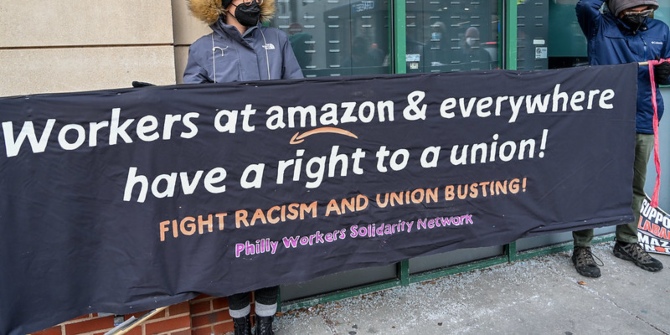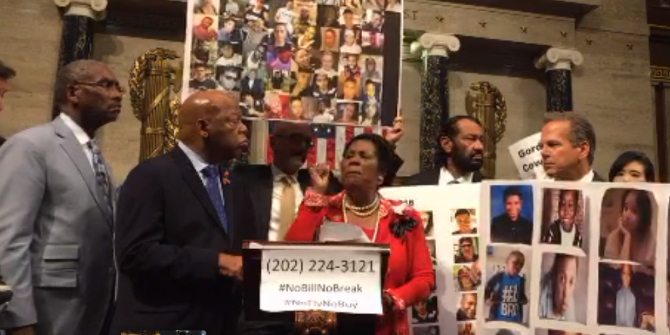 Who is arrested in a criminal justice system can be affected by those who work within it, including street-level bureaucrats like police officers and elected officials, including sheriffs and state attorneys. In new research covering Florida, William T. Jackson and co-authors examine the symbolic effects of race and political ideology, of elected officials on prosecution and arrest rates. They find that in counties with a Black sheriff, Black youth were less likely to be arrested, suggesting the importance of representative bureaucracy. By contrast, Black youth were more likely to be prosecuted if there is a Black state attorney, an effect which may be explained by partisanship.
Who is arrested in a criminal justice system can be affected by those who work within it, including street-level bureaucrats like police officers and elected officials, including sheriffs and state attorneys. In new research covering Florida, William T. Jackson and co-authors examine the symbolic effects of race and political ideology, of elected officials on prosecution and arrest rates. They find that in counties with a Black sheriff, Black youth were less likely to be arrested, suggesting the importance of representative bureaucracy. By contrast, Black youth were more likely to be prosecuted if there is a Black state attorney, an effect which may be explained by partisanship.
How do elected top law enforcement officials, such as sheriffs and state attorneys, influence justice outcomes at the street level? While selected by a popular vote, these officials perform essentially administrative functions. As agency heads, they can influence street-level bureaucrats directly through the chain of command, and indirectly through the signals their political and social identities sent to the frontline workers. By focusing on elected executives in law enforcement, we can investigate how their partisanship and race/ethnicity affects bureaucratic behavior on the ground and test the explanatory power of two theories—political control of the bureaucracy and representative bureaucracy.
How does the identity of elected officials and street-level bureaucrats affect criminal justice outcomes?
In new research, we focus on the juvenile justice system, where the outcomes often have life-changing consequences for delinquent youth and disparities among juvenile social groups are generally perpetuated in the adult criminal justice system. Disparities are conceptualized as the overrepresentation of Black and Hispanic youth in arrests, alternatives, and prosecutions.
Data from Florida’s 67 counties from 2015 to 2020 shows that Black youth experience disparate justice outcomes compared to Hispanic youth. We also find that the sheriff’s race affects the disparities in Black youth arrests more than the sheriff’s ideology. Having a Black sheriff mitigates disparities in Black youth arrests. Yet, we also found an increase in Black youth prosecutions among counties with Black state attorneys.
Our study makes three main contributions. First, it examines an important but understudied question about the impact of top elected officials’ identities and whether these predict street-level bureaucratic outcomes in an essential local government service—justice provision. Specifically, the political affiliation and race/ethnicity of the most powerful law enforcement actors at the local level—the sheriff and state attorney—affect outcomes for minority youth. Although police officers make the actual arrests, their behavior is shaped by messages they receive from the upper echelon of their agencies.
Second, top law enforcement officials are principals within their respective agencies and can affect the behaviors of their subordinates in direct and indirect ways. Studying elected executives allows us to compare the relative explanatory power of political control and representative bureaucracy. While the former assumes that the outcomes produced by frontline officers will reflect the political preferences of elected officials, the latter posits that the social identities of office holders will generate benefits for clients with similar social identities. Our analysis suggests that representative bureaucracy explains the distribution of Black youth arrests better than political control and race appears more important than ethnicity as a mechanism of representation among minority sheriffs. In contrast, the partisanship of state attorneys explains Black youth prosecutions better than their identity does.
Third, our research examines the disparities by comparing the justice outcomes of the two main minority groups—Blacks and Hispanics—rather than between minority and majority groups. Findings reveal that minorities are far from being monolithic—Black and Hispanic juveniles are treated differently and experience disparate outcomes in arrests, alternatives, and prosecutions.In this sense, our work speaks to the comparability of minority groups’ experiences, with important implications for the provision of public services.
Political control of the bureaucracy
Political control of the bureaucracy, known also as overhead democracy, focuses on how elected officials can control bureaucrats’ actions. In the juvenile justice system, the frontline workers act as gatekeepers. The justice outcomes reflect the decisions made by law enforcement officers on whether to arrest a juvenile or issue a civil citation and by state prosecutors on whether to prosecute the detained youth. We expect non-Republican sheriffs and Democrat state attorneys to directly advocate or indirectly signal a less punitive approach to crime to frontline workers than Republican sheriffs and state attorneys. Thus, the political control hypotheses explores the party differences toward crime control and their effect on Black and Hispanic youth.
Representative bureaucracy
Representative bureaucracy is another mechanism to ensure that administrators promote the public interest. While active and passive representation are functions of the elected official, symbolic representation reflects how others perceive the official holding a public post. Like political control, the effect of representative bureaucracy goes through direct and indirect pathways. Sheriffs and state attorneys can actively represent the groups with whom they identify, as a direct pathway, by issuing directives or setting procedures that benefit those groups.
Indirectly, agency heads send signals via their social identities. The election of a minority sheriff or state attorney indicates a community preference for greater inclusiveness and equity and has a symbolic impact at street level. Thus, deputies and state prosecutors may be less rigid when deciding whether to arrest or whether to prosecute a youth from the same racial/ethnic background as the respective county sheriff or chief prosecutor.
Disparities in justice outcomes among minority groups
To assess the disparities in the distribution of arrests, alternatives, and prosecutions among minorities, we analyze the justice system outcomes for each youth group on its respective population in a county (Black Youth and Hispanic Youth). Our results point to significant disparities in justice outcomes among minority groups with an overrepresentation of Black youth in arrests, alternatives, and prosecutions. The results show that Hispanic youth are “underrepresented” along all three outcomes.
Testing the effects of political control and representative bureaucracy
To compare the explanatory power of political control theory and representative bureaucracy, we test if the outcomes for minority groups are conditional on political and group identity of top law enforcement officials. Black Youth and Hispanic Youth are interacted with the variables capturing the sheriff’s and state attorney’s party affiliation and race/ethnicity.

“Inmates at Hillsborough County Juvenile Detention Center 2020” by Se315, is CC BY-SA 4.0, via Wikimedia Commons
In counties with a Democrat state attorney, the prosecution rate for Blacks drops to 1.38 versus 1.81 elsewhere. Regarding the effects of representative bureaucracy, the estimations show a strong representative effect for Black sheriffs and the opposite effect for Black state attorneys. The interaction coefficient of Black Youth × Black Sheriff indicates that counties with a Black sheriff have a statistically significant lower arrest rate. As Figure 1 shows, in counties with a Black sheriff, Black youth are only 14 percent more likely to be arrested relative to their representation in the overall population compared to 79 percent in other counties.
Figure 1 – Predicted Black Youth Arrests for Counties with Black Sheriff

Yet, having a Black state attorney has a significant impact on the rate of prosecution of Black youth that runs contrary to the expectations of representative bureaucracy theory. Black youth are 57 percent more likely to be prosecuted if there is a Black state attorney than in other counties (Figure 2).
Figure 2 – Predicted Black Youth Prosecutions for Counties with Black State Attorney

Having a Democrat state attorney does not affect the prosecution rate of Hispanic youth. We find no support for representative bureaucracy based on ethnicity. Given that state attorneys can prosecute only arrested youth, we estimate the prosecution models while controlling for arrests within each minority group. In terms of representative bureaucracy, there is still a significant effect of having a Black state attorney, as Figure 3 shows, which runs contrary to our expectations.
Figure 3 – Predicted Black Youth Prosecutions for Counties with Black State Attorney Controlling for Black Youth Arrests

Implications for Scholars and Practitioners
Our findings have implications for the theory and practice of public administration. First, the finding that the race of top elected officials affects the outcomes of the juvenile justice system indicates the need to account for principals’ identity, not just agents’ identity. Second, we find that sheriffs affect the street-level outcomes more through race than ideology, that is, the theory of representative bureaucracy explains street level arrests better than political control. Yet, state attorney’s partisanship influences frontline workers’ behavior more than their racial/ethnic identity. Third, race appears to be more important than ethnicity as a mechanism of representation among minority sheriffs in Florida.
Lastly, the results show that the minorities are not a monolithic group. In justice provision, Hispanics share more similar experiences with Whites than Blacks, likely due to Florida politics. Our findings call for scholars to explain better the disparate dynamics across minority groups and for practitioners to balance the scales in the provision of justice.
- This article is based on the paper ‘Justice in Black and Brown: The impact of political control and representative bureaucracy on street level outcomes’ Public Administration Review.
- Please read our comments policy before commenting.
- Note: This article gives the views of the author, and not the position of USAPP – American Politics and Policy, nor the London School of Economics.
- Shortened URL for this post: https://bit.ly/3pFPOCA






